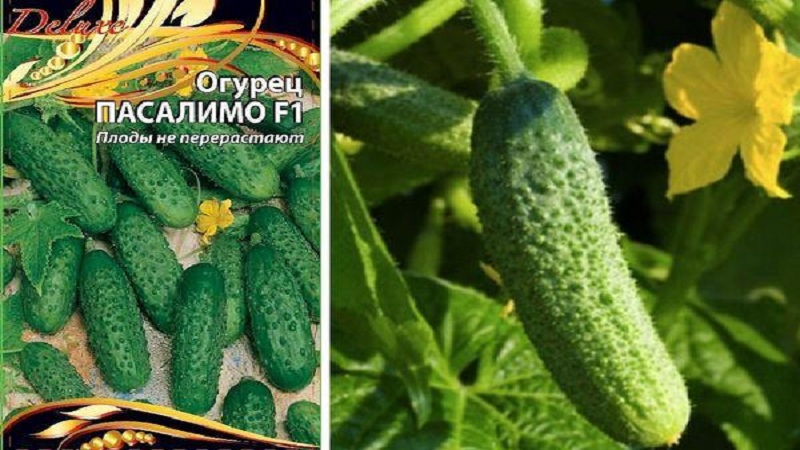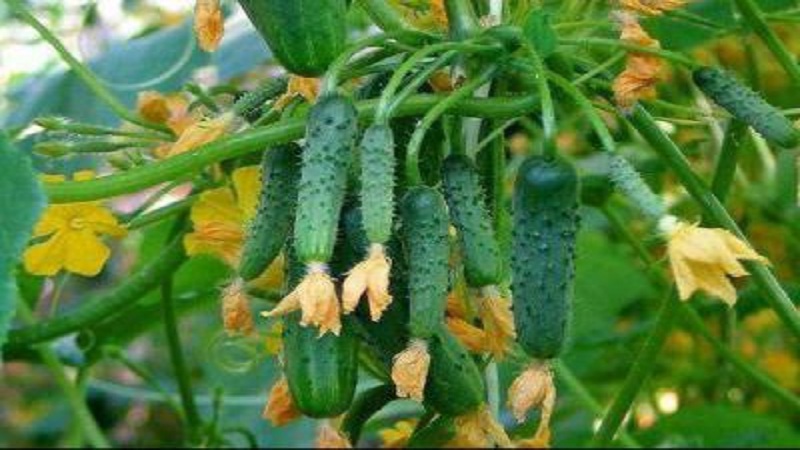Why the Pasalimo f1 cucumber hybrid is good and why it is worth trying to grow it
Cucumber Pasalimo f1 is an early maturing Dutch hybrid suitable for growing throughout Russia. The crop is distinguished by a long fruiting period, and with the correct shaping of the bushes, it guarantees a double harvest. Emerald dense skin with a lot of tubercles and crispy flesh without voids allows you to use pickles and gherkins for preparing winter preparations.
The culture has won the love of farmers due to its high productivity with minimal labor and financial investment. In this article we will talk about the pros and cons of the hybrid, the features of agricultural technology, methods of dealing with the usual mosaic of cucumbers and insects.
The content of the article
Description of the hybrid
Cucumber Pasalimo f1 was developed by biologists of the Dutch company Syngeta seeds.
It is characterized by an early ripening period, has a female flowering type. Bushes - medium-sized, vigorous, with unlimited growth of the main stem. The fruits are of the gherkin type. In one node, from 3 to 6 zelents are formed. In the photo - Pasalimo cucumbers. Distinctive features are presented in the table: The calorie content of cucumbers is only 14 kcal per 100 g. Chemical composition of the product: Regular consumption of cucumbers has a positive effect on the body: Cucumbers Pasalimo f1 are grown through direct sowing in the ground in early May, through seedlings - in early April. Agrotechnology for cucumbers is standard. The culture needs proper watering, depending on weather conditions, loosening and weeding of the soil, feeding with organics and minerals, forming bushes. Cucumbers love warmth, so direct sowing is done in early May. Soil temperature should be + 15-18 ° С, air temperature - stable + 20 ° С during the day and + 15 ° С at night. The plot for sowing is chosen from the south side. In autumn, the soil is dug up, fertilized with humus (10 liters per 1 m²). In the spring, they are loosened and fed with chicken droppings (10 liters per 1 m²). Wood sawdust and peat are mixed into the soil. Seeds are embedded in holes to a depth of 2-3 cm, with an interval of 20 cm. The distance between the rows is 70 cm. The beds are watered with warm water and covered with agrofibre to protect against frost. The culture is characterized by early fruiting, therefore, sowing seeds for seedlings is carried out at the end of April. The seedling method significantly shortens the ripening period.In unprotected soil, the crop is harvested 14 days earlier than cucumbers grown in the greenhouse. The seeds of the hybrid do not require pre-sowing disinfection and treatment with germination stimulants. The material is pre-processed before packaging. The main stages of cultivation:
Indicators
Characteristic
Ripening period
39-41 days
Pollination type
Parthenocarpic
Weight
80-90 g
Length
5-8 cm
The form
Cylindrical
Coloration
Dark green with short stripes, slight mottling
Leaves
Medium in size, light green
Pulp
Thick, crispy, juicy
Taste
Refreshing without bitterness
Skin
Dense, large lumpy, with a white edge
Appointment
Universal
Yield
14 kg / m²
Sustainability
Olive spot, powdery mildew.
Transportability
High
Chemical composition, calorie content and benefits
Hybrid agricultural technology
Seed planting

Growing seedlings
Growing and care
Cucumbers prefer loose and nutritious soil with a neutral pH = 7. The best crop precursors are dill, parsley, legumes, cabbage, onions, and garlic.
Rules for successful farming:
- Loosening the soil after watering and weeding.
- In dry weather and during active fruiting, plants are watered strictly at the root every day. In cold and rainy weather, watering is temporarily stopped - hypothermia of the roots leads to infection with bacterial infections.
- The culture is fed with organic and mineral supplements, alternating each of them. In total, up to five portions of fertilizers are applied twice a month.
Feeding scheme:
- 10 days after planting - 10 g of urea, 10 g of superphosphate, 20 g of sodium humate per 10 liters of water;
- during flowering and fruiting - 25 g of nitrophoska, 20 g of chicken manure per 10 liters of water;
- subsequent feeding - 10 g of potassium sulfate, 500 ml of cow manure per 10 liters.
To improve the composition of the soil, accelerate plant growth, increase immunity, yeast fertilizers are used: 500 g of rye bread, 500 g of tops or nettles, 500 g of pressed yeast pour 10 liters of warm water and leave for 48 hours. The product is poured under the root.
Ready-made humic dressings are popular: "Breadwinner", "Bud", "Ideal", "Fertika Lux", "Zdraven", "Fertility".
Features of cultivation and possible difficulties
To achieve the maximum productivity of the Pasalimo f1 hybrid, the bushes are molded:
- The main lash is pinched after 5-6 sheets. This stimulates the growth of additional shoots, on which the bulk of the fruit is formed.
- Lateral shoots are pinched over 2-3 leaves.
- Flowers and side shoots up to 6 leaves are removed.
- The lower leaves are trimmed as the bush grows to improve ventilation.
- Shoots that have given up the entire crop are removed to stimulate new ovaries.
When properly formed, cucumber bushes bear fruit before the onset of frost.
Pasalimo is an indeterminate hybrid with unlimited growth of the main stem, therefore it needs a garter to the trellis. The manipulation is carried out after the appearance of 5-6 leaves.
Diseases and pests
The culture has immunity to olive spot and powdery mildew, partially tolerant to the common virus mosaics.
Signs of this disease are rarely seen at the seedling stage.
Infection is recognized during the period of active plant growth:
- mottling on the leaves;
- deformation and curling of leaves with edges down;
- growth retardation of bushes;
- yellow specks and bumps on the fruit.
The main carrier of the tobacco mosaic virus is melon aphid.
Control methods:
- weeding with complete weed control;
- harvesting plant residues in the off-season;
- the use of sterile tools when working with plantings of cucumbers;
- soil treatment with copper sulfate (50 g of substance per 10 liters of water);
- control of aphids on the site;
- treatment with a 3% solution of the drug "Pharmayod-3".
Fight aphids help:
- insecticides "Tanrek", "Danadim", "Decis", "Confidor";
- biological products "Bitoxibacillin", "Aktofit", "Fitoverm", "Entobacterin".
In parallel, they are fighting ants, because it is they who bring aphids to the site. To scare away insects, use the "Anteater" agent, pour boiling water over the anthills, and frequently loosen the soil.
Council. Sow anise, oregano, marigolds, daisies, cumin next to cucumber plantings to attract ladybirds - faithful helpers in the fight against melon aphids.
In addition to aphids, spider mites love to feast on juicy cucumber leaves. In this case, folk remedies will come to the rescue:
- Pour 30 g of chopped dry dandelion roots into 1 liter of water and leave for three hours. Spray cucumbers twice a week.
- The hogweed root, collected before flowering, pour 10 liters of water. After a day, process the bushes.
- 100 g of dry leaves of dope ordinary pour 1 liter of warm water. After 12 hours, strain and process the bushes.
- Fill the bucket halfway with dry marigold flowers and cover with warm water. Insist 48 hours, strain and dissolve in the infusion 50 g of shavings of laundry soap. Treat bushes in dry evenings once a week.
Cucumber plantings often affect slugs. To get rid of the pest, they carry out manual collection at night, irrigate the bushes with a solution of ammonia (2 tablespoons per 1 liter of water), sprinkle the beds with eggshells, tobacco makhorka, coniferous needles, hot pepper.
Harvesting and application of the crop
The first crop is harvested approximately 40 days after the entries. Cucumbers grow in bunches, and scissors are used to carefully remove ripe specimens.
Zelentsy are not prone to overgrowing, but frequent harvesting stimulates the growth of the following fruits.
The hybrid is suitable for picking 3-5 cm pickles for pickles and pickling, gherkins 5-8 cm long. Fruits are equally good in fresh and canned form.
Cucumbers perfectly tolerate long-distance transportation without losing their presentation. Store in a cool room for up to three weeks.
Advantages and disadvantages
Hybrid advantages:
- evenness of cucumbers;
- keeping quality;
- early maturity;
- abundant fruiting before frost;
- unpretentious care;
- universal use in cooking;
- resistance to olive spot and powdery mildew;
- the ability to collect pickles and gherkins;
- great taste;
- lack of bitterness;
- firm, crispy flesh without voids.
The disadvantage is the need to form the bushes.

Reviews
The Dutch hybrid is highly regarded by gardeners for its high productivity with minimal labor costs. Consumers love small crunchy cucumbers that stay fresh for a long time.
Edward, pos. Rzhaksa: "I plant Pasalimo cucumbers in the greenhouse through seedlings. The seeds have excellent germination and do not need additional processing. I form bushes into one stem and get two harvests per season. Cucumbers are dense, with a harsh skin, but tasty and aromatic. I use it for pickling and pickling in vinegar. "
Maria, Lgov: “Pasalimo first purchased the seeds of the hybrid last year. I planted several bushes for testing in the country in the garden. Culture loves water and sunlight. With a lack of lighting, it sets fruit poorly. For top dressing I use ready-made humic fertilizers, do weeding and remove weeds. "
Conclusion
Pasalimo is a parthenocarpic hybrid of the gherkin type. The short, even fruits are suitable for harvest at the milky stage. These are often used to prepare savory pickled snacks.
Agrotechnics of culture is not difficult even for novice gardeners.Like any other Dutch hybrid, Pasalimo requires frequent watering during fruiting, mineral and organic fertilizing.
The plant is resistant to olive spot and powdery mildew, but is prone to the usual mosaic of cucumbers. Removing weeds from the site, disinfecting the soil, and killing aphids will help to cope with the disease.